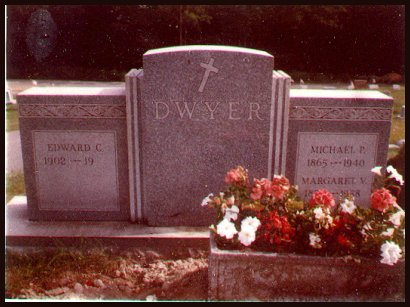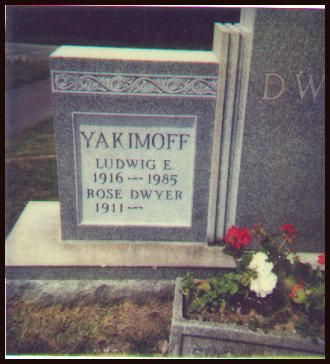No Brief Candle
A Family History Project
May 30, 1999
Sunday
Readers of other areas of The
Silken Tent are perhaps aware of my love of cemeteries. I have
posted no fewer than three pictures of graves, written about visits to
a number of burial grounds, and referred to my membership in the Association
for Gravestone Studies and the Berks County Association for Gravestone
Preservation. I am a certified, recognized taphophile -- a person who loves
tombs (taphs).
Tomorrow I am visiting the cemetery in Mahanoy City, Pennsylvania where
my parents and most of my mother's relatives are buried. Although my sister
and I usually make our annual pilgrimage in late June, my visit this Memorial
Day weekend is motivated in part by a desire to honor my father's military
service.
As cemeteries go, the ones in Mahanoy City are rich in the things that
make such places fascinating for me. More than a dozen of them dot the
hill above the town. There are several Protestant cemeteries, a nondenominational
area where the town's war memorials are situated, and a small Jewish cemetery.
Through about the first half of this century, the Catholics in town attended
ethnic parishes, where the liturgy was in Latin and the Scripture readings
and the sermon were given in the vernacular -- Italian at Sacred Heart,
German at St. Fidelis, Lithuanian at St. Mary's, etc. There was also a
cemetery for black people.
My mother's family, the Dwyers and the Waters clans, belonged to St.
Canicus Parish, for the Irish. Her grandparents and some aunts and uncles
on both sides are buried there. When my grandfather died in 1940, my grandmother
made what was the largest purchase of her life -- she bought a four-space
plot near the east edge of St. Canicus Cemetery, and had a handsome stone
erected.
 Here
is the Dwyer stone as it looked in 1985. The right-hand panel notes the
dates of my grandfather, Michael P., 1865 -- 1940, and my grandmother,
Margaret V., 1878 -- 1958. The left hand panel bears the name of my Uncle
Ed, Michael and Margaret's oldest child, and his birth date, 1902. The
space below, for the occupant of the fourth seat, has been left blank.
I think my grandmother would like it that the flowers obscure her birthdate
in this picture -- when the stone was originally set, she ordered that
only the first two digits of her birth year be engraved.
Here
is the Dwyer stone as it looked in 1985. The right-hand panel notes the
dates of my grandfather, Michael P., 1865 -- 1940, and my grandmother,
Margaret V., 1878 -- 1958. The left hand panel bears the name of my Uncle
Ed, Michael and Margaret's oldest child, and his birth date, 1902. The
space below, for the occupant of the fourth seat, has been left blank.
I think my grandmother would like it that the flowers obscure her birthdate
in this picture -- when the stone was originally set, she ordered that
only the first two digits of her birth year be engraved.
And thereby hangs a tale.
This story was given to me when I was 11, after my grandmother's funeral,
when I saw the gravesite for the first time. I asked why Mammam's birthdate
was not complete, and why the name of Aunt Jo, Uncle Ed's wife, was not
included.
Michael Dwyer married late in life. One of a dozen children, he had
left school before he was in his teens to work in the coal mines. It was
his labor that helped support his younger siblings, including his brother
Will who was able to complete high school and enter the seminary to study
for the priesthood. Later Michael schooled himself in academic subjects
so that he could secure a non-mining job before starting his own family.
So Mike was 36 when he married Margaret Waters, then 22 and a seamstress.
They took their honeymoon at Niagara Falls, arriving the same weekend that
President McKinley died there. They spent part of the trip watching his
funeral train depart. I've often wondered about a marriage that had this
as its central honeymoon memory.
Mike and Maggie had not quite 40 years together. When he died, his widow
directed that only the first two digits of her birthdate be engraved on
the stone.. This was, she said, because she didn't want people walking
around on Decoration Day saying, "Why, I didn't know Mike was 13 years
older than Maggie!!"
In addition to his widow, Michael Dwyer was survived by three children
-- Edward, then 38, married, and living in Delaware where he managed the
F.W. Woolworth store; Mary, 32, married with one child and living in Shenandoah
where she and her husband operated a grocery store; and my mother Rose,
29, unmarried, and living at home (which, considering the societal expectations
of the day, was probably considered her permanent situation).
One would think, then, that if any of the Dwyer children would be laid
to rest beside their parents, it would be Rose. But Margaret Dwyer chose
to have her nearly 40-year-old married son's name engraved on the stone.
And what about that fourth spot -- why is it blank instead of bearing the
name of Uncle Ed's wife?
At the time, Ed was married to a woman named Esther whom my mother remembered
as a lovely woman of exquisite taste and bearing. One thing Esther was
not, however, was Catholic, and in those days non-Catholics could not be
buried in the "consecrated ground" reserved for Catholics. In all likelihood,
my grandmother's decision regarding the engraving of the stone reflects
a certain possessiveness of her son and an awareness of this particular
rubric, and not a deliberate slight of Esther.
I have only a dim memory of Aunt Esther. She died in the early 1950's
and was buried near the home she shared with Uncle Ed in Wilmington, Delaware.
My mother remembered her brother telling her in the cemetery that it was
his express wish to occupy an adjoining plot when the time came.
Not long afterward, Uncle Ed remarried, this time to an Italian woman
who became my Aunt Jo. When Ed died in 1963, my mother did not feel it
was her place to tell the widow what to do. So Uncle Ed wound up in the
same cemetery as his first wife, but a few rows over. For the 35 years
that Aunt Jo was a widow (she died last fall) she never visited his grave
without also visiting Esther's, and leaving flowers at both. I always thought
that was classy.
That did, however, leave two available plots up in Mahanoy City. My
mother and her sister Mary, always the frugal ones, quietly agreed that
whoever had the need first would make use of them.
And so it happened that when my father died in June of 1985, my mother
took possession of those two spots. I remember that on the morning of the
funeral I received a call from the St. Canicus Cemetery office. The man
said he had an order to open a grave for one Ludwig Yakimoff, but Edward
Dwyer's name was on the stone. I assured the man that Edward had secured
other accommodations. Thus it was that my father spent about a year not
in an unmarked grave, but in somebody else's grave.
 I
have a letter from Edgar W. Everett of E.T. Everett & Sons, Memorial
Designers and Craftsmen (the firm that fashioned and set the stone back
in 1940) asking that my mother call to discuss the various options he had
developed regarding how to alter the names to reflect the correct information.
The work was done in the spring of 1986, after the frost had passed, and
my mother was billed $209. The result is seen at right.
I
have a letter from Edgar W. Everett of E.T. Everett & Sons, Memorial
Designers and Craftsmen (the firm that fashioned and set the stone back
in 1940) asking that my mother call to discuss the various options he had
developed regarding how to alter the names to reflect the correct information.
The work was done in the spring of 1986, after the frost had passed, and
my mother was billed $209. The result is seen at right.
My father's decidedly non-Irish name is not so out of place anymore
among the Fogartys and Flahertys and Dugans which surround the Waters-Dwyer
plots. What were once discrete ethnic communities have given way to America's
melting pot. As the population of the region has declined, so have the
number of Catholic parishes, so that St. Canicus and St. Fidelis have merged,
maintaining a hyphenated name but accepting any soul who wishes to call
it his spiritual home.
As a cemetery connoisseur I would find great delight in this story no
matter whose it was. That it springs from my own family is a double treat.
It shows me a side of my grandmother I was unable to grasp when I was 10,
and reminds me of what folly we undertake when we seek to control the way
people remember us.
(Previous --
Next)
This journal updates irregularly.
To learn when new pieces are added,
join my
Notify
List.
Return
to The Silken Tent Main Page
Return
to No Brief Candle Index
The
contents of this page are © 1999 by Margaret DeAngelis.
This
site is hosted by Dreamhost.
They're dreamy!
 Here
is the Dwyer stone as it looked in 1985. The right-hand panel notes the
dates of my grandfather, Michael P., 1865 -- 1940, and my grandmother,
Margaret V., 1878 -- 1958. The left hand panel bears the name of my Uncle
Ed, Michael and Margaret's oldest child, and his birth date, 1902. The
space below, for the occupant of the fourth seat, has been left blank.
I think my grandmother would like it that the flowers obscure her birthdate
in this picture -- when the stone was originally set, she ordered that
only the first two digits of her birth year be engraved.
Here
is the Dwyer stone as it looked in 1985. The right-hand panel notes the
dates of my grandfather, Michael P., 1865 -- 1940, and my grandmother,
Margaret V., 1878 -- 1958. The left hand panel bears the name of my Uncle
Ed, Michael and Margaret's oldest child, and his birth date, 1902. The
space below, for the occupant of the fourth seat, has been left blank.
I think my grandmother would like it that the flowers obscure her birthdate
in this picture -- when the stone was originally set, she ordered that
only the first two digits of her birth year be engraved.
 I
have a letter from Edgar W. Everett of E.T. Everett & Sons, Memorial
Designers and Craftsmen (the firm that fashioned and set the stone back
in 1940) asking that my mother call to discuss the various options he had
developed regarding how to alter the names to reflect the correct information.
The work was done in the spring of 1986, after the frost had passed, and
my mother was billed $209. The result is seen at right.
I
have a letter from Edgar W. Everett of E.T. Everett & Sons, Memorial
Designers and Craftsmen (the firm that fashioned and set the stone back
in 1940) asking that my mother call to discuss the various options he had
developed regarding how to alter the names to reflect the correct information.
The work was done in the spring of 1986, after the frost had passed, and
my mother was billed $209. The result is seen at right.